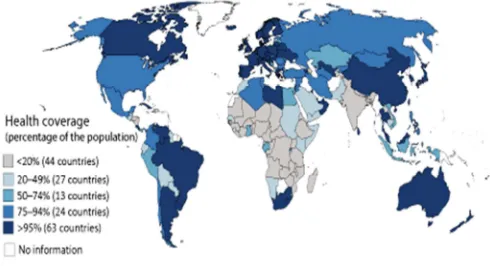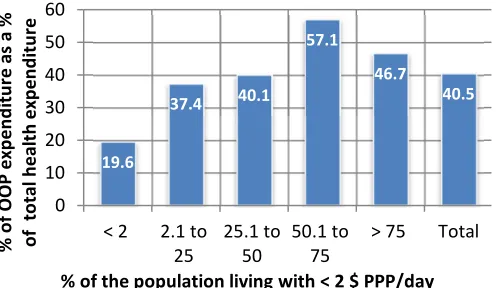Rapid extension of health protection
Social Protection for All Policy Brief No. 2
September 2014
This Policy Brief summarizes the limited coverage of health protection today and suggests three steps to rapidly extend health protection and achieve universal health coverage that is sustainable and allows for returns in terms of socio-economic development and inclusive growth.
Where do we stand today?
Observation 1 on Coverage: In Globally 44 Countries Less Than 20 % of The Population has a Right to Coverage anchored in a Health System or Scheme
• In more than 70 countries less than half of the population is covered.
• At the global level, 40 % of the population is without any form of legal health coverage.
• Most substantial gaps exist in countries with highest poverty levels: In Sub-Saharan Africa and India more than 80 % of the population is not affiliated to any health system or scheme.
Figure 1: Global legal health coverage
Source: ILO World Social Protection Report 2014/2015
As a result, effective access to needed health care is very limited. In low income countries, the gaps in the number of health workers leave more than 80 % of the population without access to care, the financial
deficit excludes more than 90 % from access and out-of-pocket payments (OOP) constitute high barriers as they exceed 47 % of total health expenditure. This results in a maternal mortality ratio which is as high as 37.5 deaths per 10,000 live births.
Figure 2: Access gaps to health care in low income countries, 2011.
Source: ILO World Social Protection Report 2014/2015
Observation 2 on Impoverishment: In Many Poor Countries Private OOP Exceed Public Health Expenditure and Drive People into Poverty
• Globally, more than 40 % of total health expenditure is financed from private resources, often pushing people into poverty when in need of care and unable to work and generate income
• In countries where more than half of the population is living on less than 2 US$ a day, about 50 % of total health expenditure derives from OOP.
• One hundred million people fall into poverty when accessing health care.
90.3 82.5
92.6 47.8 37.5
0 20 40 60 80 100
Legal health coverage deficit as a % of total pop. Staff access deficit (threshold:
41,1/10,000) Financial access deficit
(threshold: 239USD) OOP as % of total health
expenditure Maternal mortality ratio (per
2 Social Protection for All Policy Brief No. xx
Figure 3: OOP as a % of total health expenditure by country level of poverty
Source: ILO World Social Protection Report 2014/2015
Observation 3 on Health Workforce Shortages: A Global Gap of 10.3 Million Health Workers Hampers Progress towards Universal Health Protection
• The health workforce is critically important to ensure the availability of quality care. ILO estimates that a country should have at least 41.1 health workers per 10,000 people to be able to provide essential health care to all in need.
• The global shortage of 10.3 million health workers is unevenly distributed: the majority is missing in Asia (7.1 million) and Africa (2.8 million) and within these countries in rural and urban slum areas.
Figure 4: Global Health Workers Deficit (10.3 million)
Source: ILO World Social Protection Report 2014/2015
What is the Impact of Recent Fiscal Consolidation
Measures?
The Erosion of Health Protection
Many people lost their health coverage due to job or income loss and thus face highest financial barriers to access care. At the same time, their demand for free public health care – suffering from health worker shortages – is increasing.
Fiscal consolidation measures included cuts in overall public expenditure in 122 countries, among them 82 developing countries. The wages of civil servants and health workers were cut or capped in as many as 98 countries, including 75 developing countries. Further, a number of countries are reforming their health systems with a focus on cost containment, generally by increasing fees and co-payments made by patients along with cost-saving measures in public health countries could be observed. Particularly concerned were the poor, women, the elderly and vulnerable groups.
Three Steps to Rapidly Extend Health Protection to
All in Need
Step 1: Taking Stock and Assessment of Gaps
Universal health protection requires rights-based and inclusive coverage resulting in access to quality services that are available, affordable and financially protected. Related gaps can be rapidly assessed by identifying
• the extent of legal coverage and exclusions e.g. of vulnerable population groups such as the poor;
• the coverage gap due to the health worker deficit based on the relative threshold of 41.1 health workers per 10,000 population;
• the impoverishing potential due to OOP that should not exceed 40 % of household income;
• the financial deficit based on the relative threshold of 239 US$ per capita;
• The rapid assessment needs to be expanded by in-depth analyses of deficits identified and actuarial studies in order to enable the development of
% of the population living with < 2 $ PPP/day
Asia - 7100000
Africa - 2800000
Latin America - 391000
Oceania - 27000
Social Protection for All Policy Brief No. xx 3
Step 2: Development of a Policy Framework and Fiscal Space
Based on national and social dialogue, a policy framework should be developed that clearly
• defines how to close coverage gaps by increasing equity and solidarity through maximizing risk pooling and minimizing OOP, particularly for poor and vulnerable population groups;
• determines at least essential benefit packages including maternal care and prevention as well as financial protection provided by the health system and each sub-scheme;
• develops new and/or improves existing financing mechanisms including taxes, contributions and/or premiums generating sufficient resources to accelerate progress and increase sustainability;
• maximises institutional and administrative efficiency;
• specifies preferences to develop fiscal space such as reallocating of current public expenditure, increasing tax revenues, introducing new sources of funding, borrowing/restructuring existing debt and adopting a more accommodating macro-economic framework (e.g. allowing for higher budget deficits);
• reduces the share of the informal economy and develops a well-functioning formal economy to increase the availability of sustainable government resources.
Step 3: Achieving Rapid and Sustainable Progress in Health Protection and Creating Returns on Investments
Within a realistic time frame for achieving universal coverage it will be necessary to focus on:
• Enshrining Access to Needed Health Care in
Legislation
Based on existing resources and expected expenditure, health financing mechanisms should be established in legislation ensuring the availability of sufficient revenues from one or more resources. In addition to general state revenue for universal services and subsidies, contribution payments for national and social insurance schemes should be based on the ability-to-pay and user fees, co-payments etc. should be minimized to avoid
impoverishing effects. If mixed schemes and systems are chosen, it is necessary to efficiently coordinate various approaches in a way that is fair, avoids fragmentation, and fights corruption.
Countries should ensure in legislation that no one is left behind and all residents and children are legally covered in inclusive legislation. Guarantees to at least essential health care should be provided with a view to meeting vital medical needs and demands including maternal and preventive care. More comprehensive benefits are to be developed as soon as the fiscal situation allows for it.
• Providing Adequate Numbers of Health Workers
that are Trained, Recruited with Decent Working Conditions and Equitably Distributed Within Countries
Governments need to balance supply and demand within national labour markets through improved working conditions, including wages. It is further important to address wage disparities across regions as well as between general practitioners and specialists. Collective bargaining is the best way to negotiate workplace arrangements that attract the necessary number and quality of health-care workers. Bilateral and multilateral arrangements are needed with a view to compensate for training costs and avoiding brain drain.
Box 1: Rapid extension to universal coverage in Thailand
Starting in 2002, Thailand implemented a Universal Coverage Scheme (UCS) that integrated existing schemes and extended coverage. 10 years later, in 2012, the sustainable UCS made needed quality care available and affordable for all. Further, the successful investments in implementing the rights to health, fair financing and good governance supported the country’s social and economic development to an upper-middle income country today.
4 Social Protection for All Policy Brief No. xx
• Guaranteeing the Provision of Effective Levels of
Financial Protection
Financial protection when accessing health care requires the minimization of fees, co-payments and other expenditure that might act as a barrier to access needed health care. Besides excessive OOP, protection from transport costs to reach health care facilities and economic loss caused by reductions in productivity and earnings due to ill health should be compensated.
• Establishing Monitoring and Social Dialogue
Regular monitoring, feedback and support through tripartite national and social dialogue should be established Thresholds should be set by the government with a view to measuring both affordability and availability of quality health care and financial protection for all in need.
• Achieving Policy Coherence
Governments are advised to strive for policy coherence across the social, economic and health sectors that emphasize poverty alleviation and labour market policies to avoid unintended increases in inequality. Best practice policies include the development of national floors of social protection as outlined in ILO Recommendation 202.
If well designed and implemented the above policies aiming at rapid extension of health protection will realize
• socio-economic development and growth through increased labour productivity, a larger labour force and the contribution of the health sector to economic activity;
• employment effects and job growth arising from both direct employment in health and multiplier effects in other sectors;
• poverty alleviation, through minimizing the private health expenditure of those who are poor or close to poverty;
• income generation due to increased ability to work;
• stabilization of the economy in times of crises by mitigating the impacts on individual health and ensuring continued employment;
• a growing tax base due to the indirect economic effects of investments in health, particularly in low-income countries.
References
ILO (International Labour Office). 2012. The strategy of the International Labour Organization. Social security for all: Building social protection floors and comprehensive social security systems (Geneva).
ILO, 2014. World Social Protection Report 2014/15: Building economic recovery, inclusive develop-ment and social justice (Geneva).
This Policy Brief was produced by Xenia Scheil-Adlung and Thorsten Behrendt, and is based on Chapter 5 of the ILO World Social Protection Report 2014-15. For more information, please refer to this report.
The editor of the series is Isabel Ortiz, Director of the Social Protection Department, International Labour Organization (ILO). For more information, contact: [email protected].

